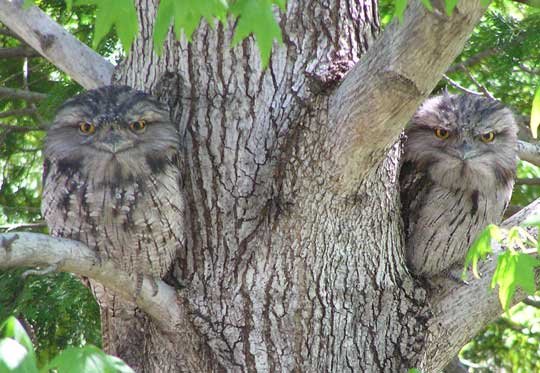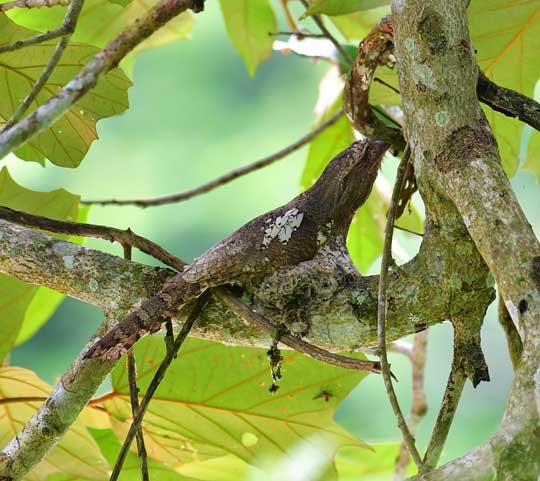|
In 1995, Trish and I were lucky enough to tour a fascinating cave in New Zealand. As we came out of the cave, there was a funny-looking bird sitting on a handrail within arm's reach of me. The bird simply stared, with no apparent urge to fly away. It had a cartoon-like face and a wide mouth that reminded me of a frog's mouth. In fact, this bird was actually a tawny frogmouth. What the heck is a Frogmouth? First of all, despite their owl-like appearance, frogmouths are not owls. They are actually related to nightjars (the nightjars are insect-eating birds with short, broad beaks... in Missouri we have three nightjars, the nighthawk, the whip-poor-will, and the chuck-will's-widow). However, frogmouths are often mistaken for owls because they are nocturnal and their feather coloration is similar to some owls. This similar appearance is a great example of convergent evolution, in which unrelated organisms evolve to look similar to each other because they are adapted to similar habitats and habits. Owls and frogmouths both hunt at night, so they both have large eyes and similar camouflage patterns. However, frogmouths do not have strong claws like owls. Owls use their claws to hunt larger prey, whereas frogmouths catch insects and small vertebrates with their mouths instead of their talons. They can open their mouths wide to scoop up flying insects. Frogmouths live across much of Southeast Asia and Australia. There are 14 species of frogmouths, but the tawny frogmouth is arguably the best known of all of them. Well, at least it's the one most frequently seen on the internet. In fact, in April 2021, German researchers did a study using an algorithm to analyze the aesthetic appeal of over 27,000 bird photos and found that Instagram users "liked" frogmouth photos more than any other bird photos. Therefore, frogmouths are officially the world's most Instagrammable bird species. Amazing Facts about Frogmouths First, I recommend that you watch this fun video about frogmouths. It's worth the five minutes of your life that it will take to watch it. Okay, if you watched the video, you probably want to know more, right? Like, did he say frogmouths bash their prey against rocks? He did indeed. Remember, owls have strong claws for killing, frogmouths don't (their feet are small and rather weak). Instead, they have... well, big mouths. They can grab prey animals that are bigger than insects (frogs, reptiles, small birds and mammals), but instead of tearing them apart with talons, they whip them against a rock or tree over and over. Then they swallow the bashed-up creature in one gulp. That's dramatic, I suppose, but the majority of a frogmouth's diet is smaller critters—nocturnal insects, slugs, snails, and worms. Most of these they see from their perch in a tree and pounce onto them on the ground. Sometimes they catch insects in flight, which unfortunately leads to these birds being hit by cars while swooping in to catch insects attracted to bright headlights. Frogmouths are really good at camouflage. You can see from the photo above that their color allows them to blend in, but that's just the beginning. When they sense danger, they get into a position that makes them look like a broken branch on the tree. Sometimes they will even sway back and forth as if the wind is blowing the tree. Frogmouths actually seek out old trees to sit in because it's easier for them to look like an old, stumpy tree limb. Below is a Javan frogmouth on its nest, trying to look invisible. I guess we need to talk about the pitiful nests these birds create (see photo above). When it comes to nest-making, frogmouths definitely would not win the Engineer-Of-The-Year award. Their nests are rather minimalistic. Sometimes they lay their eggs in the fork of a tree with hardly any nest at all. Sometimes they place a few sticks together and call it a nest. Or they use a bit of moss, lichens, or leaves. These nests are well camouflaged, but they don't do much to keep the eggs from falling out of the tree, which definitely happens sometimes. Well, perhaps they don't make the most impressive nests, but that's not to say they don't excel in other aspects of parenting. Frogmouths are excellent at sharing the duties. They are known to mate for life, and both sexes sit on the eggs—the male sits on the nest all day long, but then the male and female take turns during the night so they can both go out hunting for food. So, even though the nest is wimpy, the eggs and young are almost never left unattended. Both parents work hard to provide food for the growing chicks. Below is a Hodgson frogmouth sitting on its nest with two chicks. I can't decide if those chicks are cute or scary-looking. Frogmouths have a strange call. Sometimes they hiss or growl if they feel threatened, but their usual call is a low, monotonous wooo-wooo-wooo. Check out this video (you need to listen carefully... you can hear it in the last half). Frogmouths are good at surviving extreme temperatures. When temps get really low and food becomes scarce, frogmouths are able to go into a dormant state called torpor. This drastically lowers their heart rate, metabolic rate, and temperature, which therefore reduces their need for food. Torpor is not the same as hibernation. Hibernation is a long-term state, whereas torpor is usually only a few hours at a time. Still, frogmouths can go into torpor repeatedly, spending much of the days and nights of the cold season in a low-energy state. In the hot months, frogmouths open their mouths and pant. The moving air helps cool them down. To increase the effectiveness of this, they fill their mouths with mucus, which helps cool the air as it is inhaled. I mentioned above that frogmouths often mate for life. Continuous close proximity and physical touch seem to be important ways for frogmouth pairs to reinforce their bond (Hey, I can identify with that!). Pairs typically spend their down time sitting beside each other, even close enough that they are touching. A male often grooms the female's feathers, sometimes doing this for up to ten minutes without stopping. Below is a bonding pair of Sri Lanka frogmouths. So, the Frogmouth deserves a place in the P.A.H.O.F. (Portentous Animal Hall of Fame). FUN FACT: The word portentous originated way back in the 1540s. In fact, it was seemingly a favorite word of William Shakespeare. It came from the Latin word portentosus. The root of the word, portent, was a synonym of a sign or an omen. When the word portentous was first used, it was always in reference to an omen, usually a bad omen. However, by the end of the 1500s, the word began being used as a synonym for prodigious, which means "remarkable or impressively great in extent, size, or degree." Today, many years later, the word is often used to mean "trying to appear important and serious." Well, take one look at the frogmouth and you'll agree this definition fits. Frogmouths look very important and serious to me. So, more or less, portentous is another way to say awesome! Photo Credits:
Tawny frogmouth #1 - DepositPhotos Two tawny frogmouths on opposite sides of tree trunk - Keith Edkins, Wikimedia Commons Javan frogmouth on nest - camouflage - DepositPhotos Hodgson frogmouth with two chicks in nest - DepositPhotos Pair of Sri Lanka frogmouths - DepositPhotos
1 Comment
|
Stan's Cogitations
Everyone needs a creative outlet. That's why I write. Archives
July 2024
|






 RSS Feed
RSS Feed